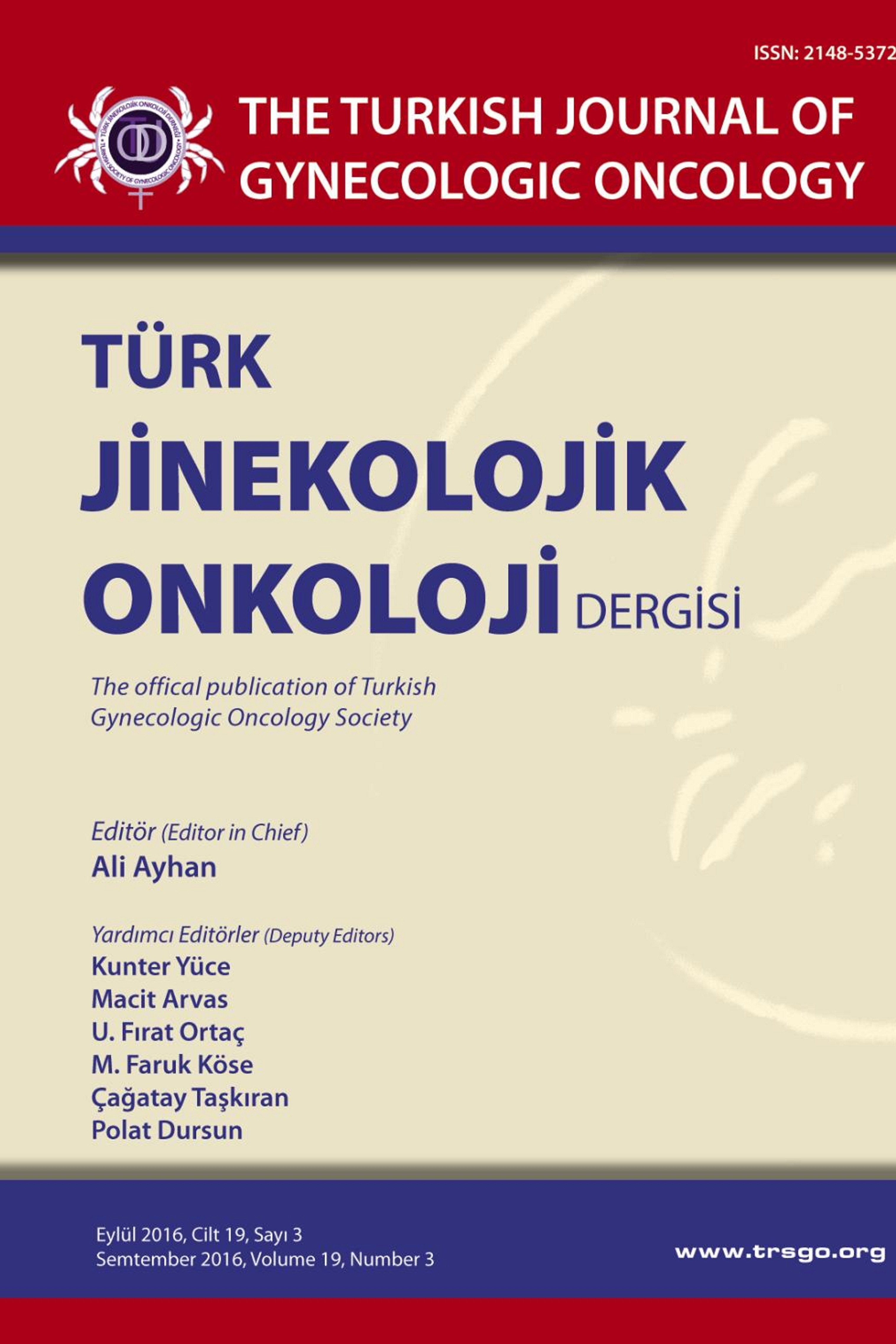ASC-H (YÜKSEK DERECELİ LEZYONUN DIŞLANAMADIĞI ATİPİK HÜCRE) SİTOLOJİ SONUÇLARININ HİSTOLOJİK OLARAK DEĞERLENDİRİLMESİ
HPV, serviks kanseri, kolposkopi, ASC-H
HISTOLOGIC EVALUATION OF ATYPICAL SQUAMOUS CELLS-CANNOT EXCLUDE HIGH-GRADE SQUAMOUS INTRAEPITHELIAL LESION (ASC-H) CYTOLOGY
HPV, cervical cancer, colposcopy, ASC-H.,
___
- 1. Globocan 2012: Estimated Cancer Incidence, Mortality and Prevalence worldwide in 2012: http://globocan.iarc. fr/Default.aspx.
- 2. Ciatto S, Cecchini S, Iossa A, et al. Trends in cervical cancer incidence in the district of Florence. Eur J Cancer 1995;31A(3):354-5.
- 3. Solomon D, Davrey D, Kurman R, et al. Th e 2001 Bethesda System: terminology for reporting results of cervical cytology. JAMA 2002; 287: 2114-9.
- 4. Davey DD, Greenspan DL, Kurtycz DF, Husain M, Austin RM. Atypical squamous cells, cannot exclude high-grade squamous intraepithelial lesion: review of ancillary testing modalities and implications for follow-up. J Low Genit Tract Dis 2010; 14: 206-14.
- 5. Galliano GE, Moatamed NA, Lee S, Salami N, Apple SK. Refl ex high risk HPV testing in atypical squamous cells, cannot exclude high grade intraepithelial lesion: a large institution’s experience with the significance of this oft en ordered test. Acta Cytol 2011;55:167–172
- 6. Mokhtar GA, Delatour NL, Assiri AH, Gilliatt MA, Senterman M, Islam S. Atypical squamous cells, cannot exclude high- grade squamous intraepithelial lesion: cytohistologic correlation study with diagnostic pitfalls. Acta Cytol 2008;52:169–177
- 7. McHale MT, Souther J, Elkas JC, Monk BJ, Harrison TA (2007) Is atypical squamous cells that cannot exclude high-grade squa- mous intraepithelial lesion clinically significant? J Low Genit Tract Dis 11:86–89
- 8. Gilani SM, Tashjian R, Fathallah L. Cervical cytology wiyh a diagnosis of atypical cells, cannot exclude highgrade squamous intraepithelial lesion (ASC-H): a followup study with corresponding histology and significance of predicting dysplasia by human papillomavirus (HPV) DNA testing. Arch Gynecol Obstet 2014; 289: 645-8.
- 9. Massad LS, Einstein MH, Huh WK, et al. 2012 updated consensus guidelines for the management of abnormal cervical cancer screening tests and cancer precursors. J Low Genit Tract Dis. 2013; 17:S1–S27.
- 10. Wu HH, Allen SL, Kirkpatrick JL, Elsheikh TM. Refl ex high-risk human papilloma virus DNA test is useful in the triage of women with atypical squamous cells cannot exclude high-grade squamous intraepithelial lesion. Diagn Cytopathol. 2006; 34:707–10.
- 11. Reid-Nicholson M, Gatscha RM, Riedel ER, Lin O. Atypical squamous cells, cannot exclude high grade intraepithelial lesion (ASC-H): Does HPV matter? Diagn Cytopathol 2007; 35:1–5.
- 12. Liman AK, Giampoli EJ, Bonfiglio TA. Should women with atypical squamous cells, cannot exclude high-grade squamous intraepithelial lesion, receive refl ex human papillomavirus-DNA testing? Cancer 2005; 105:457–60.
- 13. Xu L, Verdoodt F, Wentzensen N, Bergeron C, Arbyn M. Triage of ASC-H: a meta-analysis of the accuracy of hrHPV testing and other markers to detect cervical precancer. Cancer Cytopathol 2016; 124(4):261-272.
- 14. Patton AL, Duncan L, Bloom L, Phaneuf G, Zafar N. Atypical squamous cells, cannot exclude a high-grade intraepithe- lial lesion and its clinical significance in postmenopausal, pregnant, postpartum, and contraceptive-use patients. Cancer 2008; 114:481–488.
- ISSN: 2148-5372
- Başlangıç: 2014
- Yayıncı: Türk Jinekolojik Onkoloji Derneği
Fatma SERT, Senem ALANYALI, Arif Bülent ARAS, Zeynep ÖZSARAN
HUMAN PAPİLLOMAVİRUS GENOTİPLERİNİN PYROSEQUENCİNG METODU İLE TESPİTİ
Serap ÖZEN, Mehmet ÇİMENTEPE, Buket ŞEFLEK, Mehmet Ali VARDAR, Derya GÜMÜRDÜLÜ, Fügen YARKIN
İLERİ EVRE YÜKSEK GRADE ENDOMETRİUM KANSERLİ HASTALARDA SAĞKALIM SONUÇLARI
Alpaslan KABAN, Samet TOPUZ, Hamdullah SÖZEN, Yavuz SALİHOGLU
GESTASYONEL TROFOBLASTİK HASTALIKLARA GÜNCEL YAKLAŞIM CONTEMPORARY
Kemal GÜNGÖRDÜK, Ceysu KOCAHAKİMOĞLU, Muzaffer SANCI, Özalp Sabit SİNAN, Varol GÜLSEREN, Dilek KARTAL
SERVİKS KANSERİ YA DA SERVİKAL İNTRAEPİTHELİAL NEOPLAZİ SAPTANAN HASTALARIN HPV TEST SONUÇLARI
